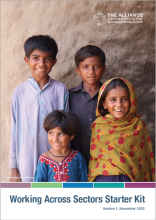
Food Security and Child Protection
Key resources developed by Alliance member organizations and relevant guidance included in the Child Protection Minimum Standards.

Les enfants sont touchés de manière disproportionnée par les crises humanitaires. Ils constituent un groupe distinct des adultes, avec des besoins et des capacités uniques qui varient selon l'âge, le sexe, les capacités, le statut juridique et d'autres caractéristiques individuelles. La place...

Travailler efficacement dans tous les secteurs pour la protection et le bien-être des enfants nécessite de nouer des relations et la collaboration avec des secteurs tels que la santé, l'éducation, la sécurité alimentaire, la coordination des camps et gestion. Les acteurs de la protection de l...

Cette note peut servir de référence au personnel de la Protection de l’enfance sur la manière de travailler avec les secteurs de distribution en situation d’urgence, pour assurer que les besoins et les préoccupations des enfants et des adolescents soient pris en compte dans leurs programmes.
Standard : Tous les enfants affectés par les crises humanitaires vivent dans un environnement de sécurité alimentaire qui atténue et prévient les risques en matière de protection de l’enfance

Le 31 octobre, l'Alliance, aux côtés du Domaine de responsabilité de la protection de l'enfance mondiale, du Cluster mondial de la sécurité alimentaire et de Plan International, a organisé un événement en ligne pour mettre en lumière l'impact de la sécurité alimentaire sur les enfants et leur...
- 839 vues
